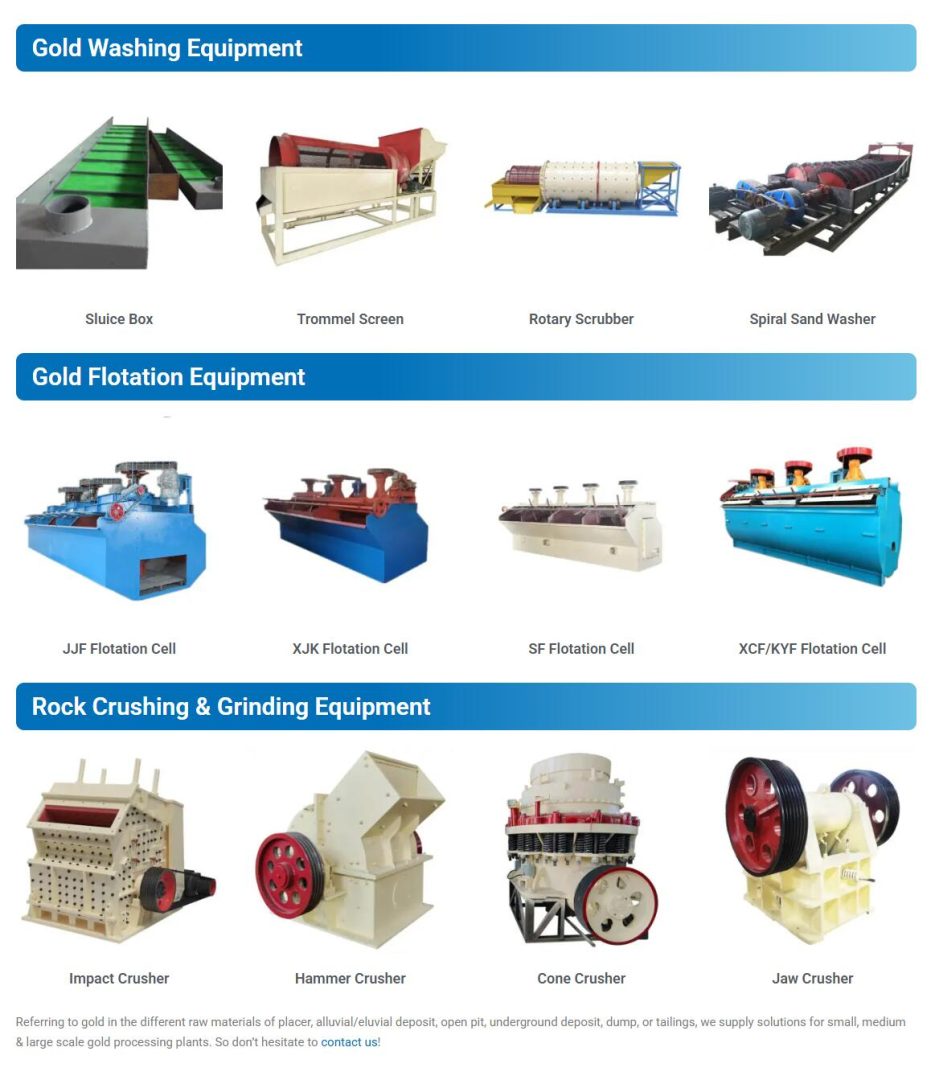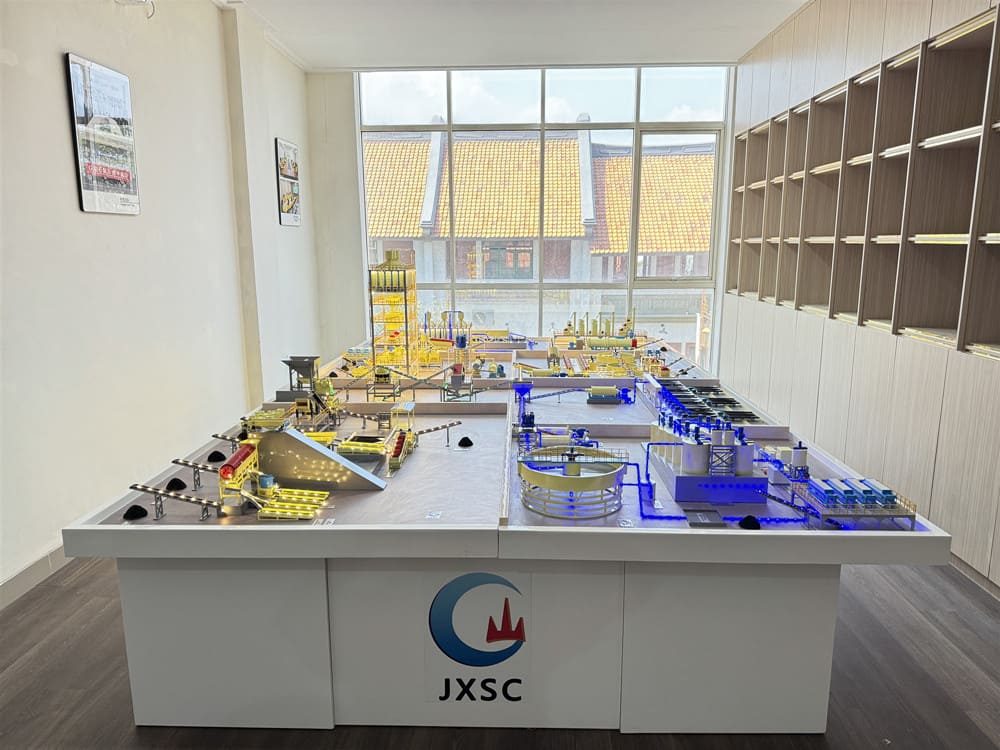Are you struggling to find the right equipment for gold mining? With so many options available, it can be overwhelming. I’ve been there, too. Let me guide you through the process so you can make an informed decision.
Gold mining equipment selection depends on the ore type, processing method, and plant capacity. The main methods include gravity separation, flotation, and cyanidation (CIP/CIL/Heap Leaching). Key equipment includes crushers, grinders, gravity concentrators, flotation cells, and leaching tanks. At JXSC, we help customers choose suitable equipment based on ore properties and production needs.
Now that we understand the basics, let’s explore each aspect of gold mining equipment selection. I’ll explain the different methods and required equipment to help you make the best choice for your operation.
Table of Contents
What Are The Methods of Gold Beneficiation?
Choosing the right gold beneficiation method is crucial. The wrong method can lead to poor recovery rates. I learned this the hard way when working with a client in Africa.
Gold beneficiation methods include gravity separation, flotation, cyanidation (CIP/CIL), and heap leaching. Gravity separation works best for coarse gold particles, and flotation for sulfide ores, while cyanidation methods are ideal for fine gold particles. Heap leaching is suitable for low-grade ores. The choice depends on gold particle size, ore type, and economic factors.
Understanding each method’s advantages helps in equipment selection:
Gravity Separation
- Best for: Coarse gold particles (>0.1mm)
- Equipment needed: Jigs, shaking tables, centrifugal concentrators
- Recovery rate: 60-90%
- Advantages: Low cost, simple operation
- Limitations: Poor for fine gold
Flotation
- Best for: Sulfide gold ores
- Equipment needed: Flotation cells, reagents
- Recovery rate: 85-95%
- Advantages: Handles fine particles well
- Limitations: Higher operating costs
| Method | Particle Size | Cost | Recovery Rate |
|---|---|---|---|
| Gravity | >0.1mm | Low | 60-90% |
| Flotation | <0.1mm | Medium | 85-95% |
| Cyanidation | Any | High | 90-99% |
| Heap Leaching | Low-grade | Medium | 60-80% |
At JXSC, we test ore samples first to recommend the most efficient method. I remember a case where switching from gravity to flotation increased recovery by 25%.
What Equipment is Needed For Gold Mining?
The right equipment makes all the difference in gold mining. I’ve seen mines fail simply because they used the wrong machinery.
Essential gold mining equipment includes crushers, grinders, classifiers, gravity concentrators, flotation cells, thickeners, filters, and smelting furnaces. Additional requirements include water treatment systems, pumps, and power generators. The exact combination depends on the chosen processing method and plant capacity.

Let’s break down the equipment by processing stage:
Crushing and Grinding
- Jaw crushers (primary crushing)
- Cone crushers (secondary crushing)
- Ball mills/Rod mills (grinding)
- Vibrating screens (classification)
Separation Equipment
- Gravity: Jigs, shaking tables, centrifuges
- Flotation: Flotation cells, conditioners
- Cyanidation: Leaching tanks, carbon columns
Auxiliary Equipment
- Thickeners
- Filters
- Pumps
- Power Systems
For small-scale miners (1-5TPD), we recommend:
- Jaw crusher
- Hammer mill
- Shaking table
- Sluice box
For large-scale operations (100TPD+), full processing plants are necessary. We recently installed a 200TPD plant in Ghana with crushing, grinding, gravity, and CIL circuits.
Which Gold Beneficiation Equipment is Most Effective?
Effectiveness in gold beneficiation isn’t universal. What works best depends on your specific situation – I learned this through years of field experience.
The most effective gold beneficiation equipment varies by ore type. For placer gold, gravity concentrators like centrifugal concentrators are most effective. Combination circuits (gravity+flotation or gravity+CIL) work best for hard rock gold. Modern centrifugal concentrators can achieve up to 98% recovery for free-milling gold ores.
Let’s compare equipment effectiveness for different scenarios:
Placer Gold Mining
- Best equipment: Trommel screens, sluice boxes, centrifugal concentrators
- Typical recovery: 85-95%
- Advantages: Simple operation, low cost
- Case study: Our client in Russia increased recovery from 70% to 93% by adding a centrifugal concentrator.
Hard Rock Gold Processing
- Best equipment: Jaw crusher → Ball mill → Gravity (Knelson) → CIL
- Typical recovery: 90-96%
- Advantages: Comprehensive recovery.
- Limitations: Higher capital cost
For refractory gold ores, additional equipment like roasters or bio-oxidation tanks might be needed. The table below shows typical recovery rates:
| Equipment | Gold Type | Recovery Rate |
|---|---|---|
| Centrifugal Concentrator | Free-milling | 95-98% |
| Shaking Table | Coarse | 85-90% |
| Flotation Cells | Sulfide | 90-95% |
| CIL Tanks | Fine | 92-96% |
How to Choose the Best Gold Beneficiation Equipment for Your Plant?
Choosing gold beneficiation equipment can make or break your operation. I’ve helped dozens of clients avoid costly mistakes.
Select gold beneficiation equipment based on: 1) Ore characteristics (grade, gold size, mineralogy), 2) Desired capacity, 3) Budget constraints, and 4) Environmental regulations. Always conduct ore testing first. Partner with experienced suppliers who offer complete solutions from testing to installation and after-sales support.
Here’s a step-by-step guide to selecting equipment:
Step 1: Ore Testing
- Chemical analysis (gold grade, impurities)
- Mineralogical study
- Process test work (gravity, flotation, leaching tests).
Step 2: Capacity Planning
- Daily throughput requirement
- Future expansion plans
- Available space
Step 3: Budget Considerations
- Capital cost vs operating cost
- Maintenance requirements
- Spare parts availability
Step 4: Environmental Factors
- Water requirements
- Tailings disposal
- Chemical usage
For example, a client in Tanzania wanted to process 50TPD of oxide ore. After testing, we recommended:- Two-stage crushing
- Ball mill grinding
- Gravity concentration (80% recovery)
- CIL for tailings (additional 12% recovery)
Total recovery increased from 75% to 92%.
Where to Find Gold Mining Equipment?
Finding reliable gold mining equipment suppliers can be challenging. I’ve encountered many operations using substandard equipment that caused constant breakdowns.
Quality gold mining equipment is available from specialized manufacturers like JXSC Mining, as well as local dealers. Key factors when choosing a supplier include: equipment quality, after-sales service, technical support, and proven track record. Avoid cheap, untested equipment that often leads to higher long-term costs.
Here’s how to evaluate potential suppliers:
Manufacturer vs Dealer
| Factor | Manufacturer | Dealer |
|---|---|---|
| Price | Medium | Low |
| Quality Control | High | Varies |
| After-sales | Best | Medium |
| Customization | Possible | Rare |
Red Flags to Avoid
- No product testing reports.
- Unwilling to provide references.
- No local service support.
- Pressure for quick decisions.

We recommend visiting the manufacturer’s facility if possible. Check their:
- Production capacity
- Quality control processes
- R&D capabilities
Customer service department
At JXSC, we offer:
- Free ore testing
- Customized flow design
- Installation guidance
- Operator training
- One-year warranty
Conclusion
Selecting the right gold mining equipment requires understanding ore properties, processing methods, and operation requirements. Gravity separation, flotation, and cyanidation are the main methods, each requiring specific equipment. Always conduct ore testing first and choose reliable suppliers. As a mining equipment manufacturer with global experience, JXSC can help you select and supply the most suitable gold processing equipment for your needs.
